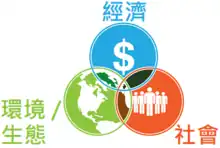三重底線
三重底線(英語:,簡稱TBL)或稱三重盈餘,是一個由社會、環境(或生態)和經濟三個部份組成的會計框架。一些組織已經採用了三重底線框架,從更廣泛的角度評估其績效,以創造更大的商業價值[1]。商業作家約翰·艾金頓聲稱在1994年創造了這個詞[2][3]。

三重底線(Triple Bottom Line)中文翻譯
參考資料
- Slaper, Timothy F. and Hall, Tanya J. (2011). "The Triple Bottom Line: What Is It and How Does It Work?" (页面存档备份,存于) Indiana Business Review. Spring 2011, Volume 86, No. 1.
- Elkington, John. . Harvard Business Review. 2018-06-25 [2019-10-11]. (原始内容存档于2022-08-31).
- . The Economist. 2009-11-17 [2014-08-14]. (原始内容存档于2018-04-28).
外部連結
- Explainer: what is the triple bottom line? - The Conversation (页面存档备份,存于)
- The Triple Bottom Line: What Is It and How Does It Work? - Indiana Business Review (页面存档备份,存于)
- Balancing Act - A Triple Bottom Line Analysis of the Australian Economy (页面存档备份,存于)
- Citizens for Corporate Redesign (页面存档备份,存于) (Minnesota)
- Triple Pundit - Blog on Triple Bottom Line (页面存档备份,存于) (United States)
- Corporate Responsibility (页面存档备份,存于) (United Kingdom)
- TBL Accounting without boundaries - Australian corporate and government experiences (页面存档备份,存于)
This article is issued from Wikipedia. The text is licensed under Creative Commons - Attribution - Sharealike. Additional terms may apply for the media files.